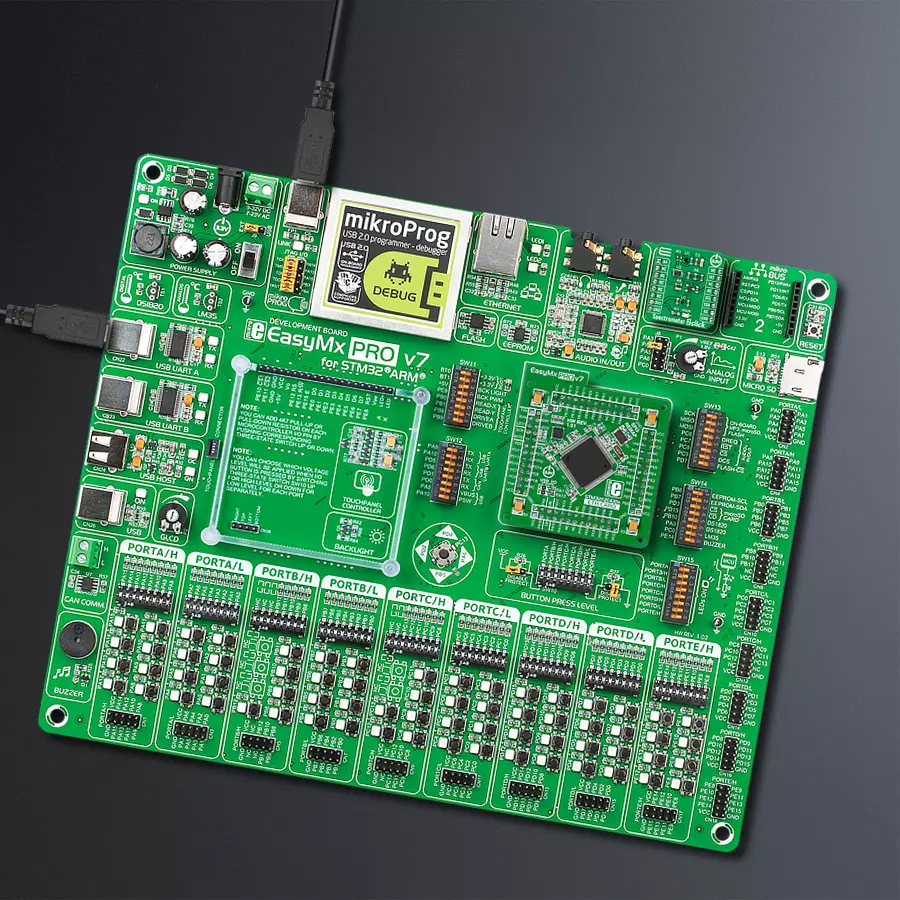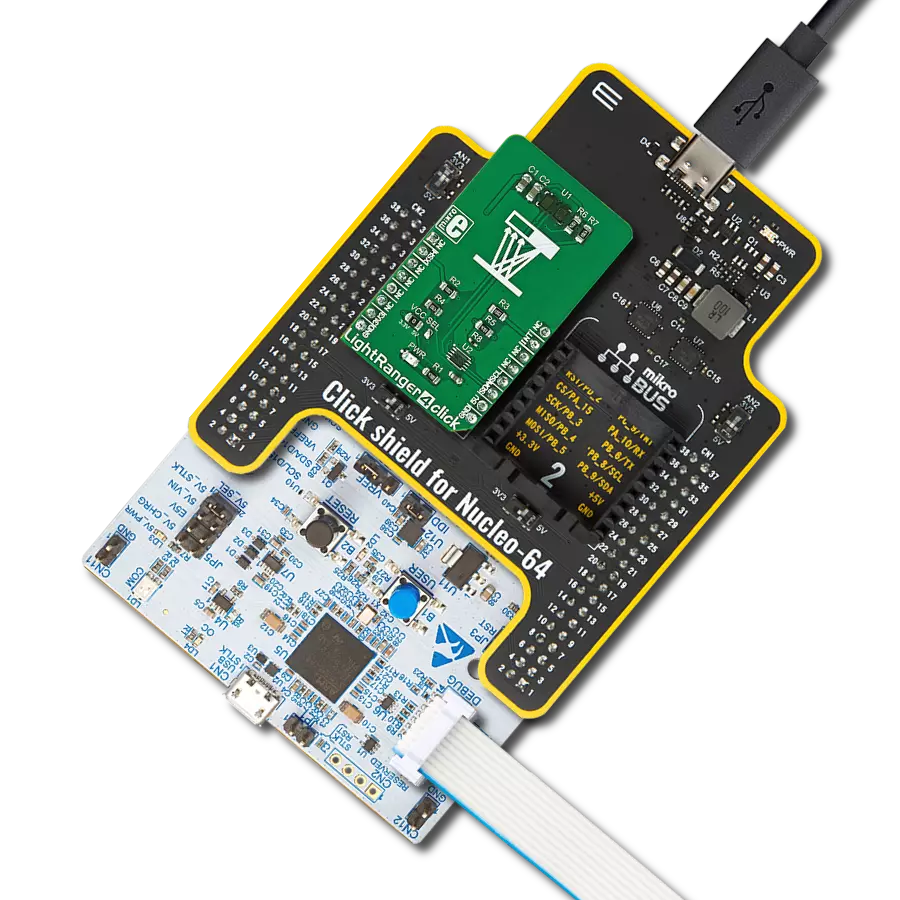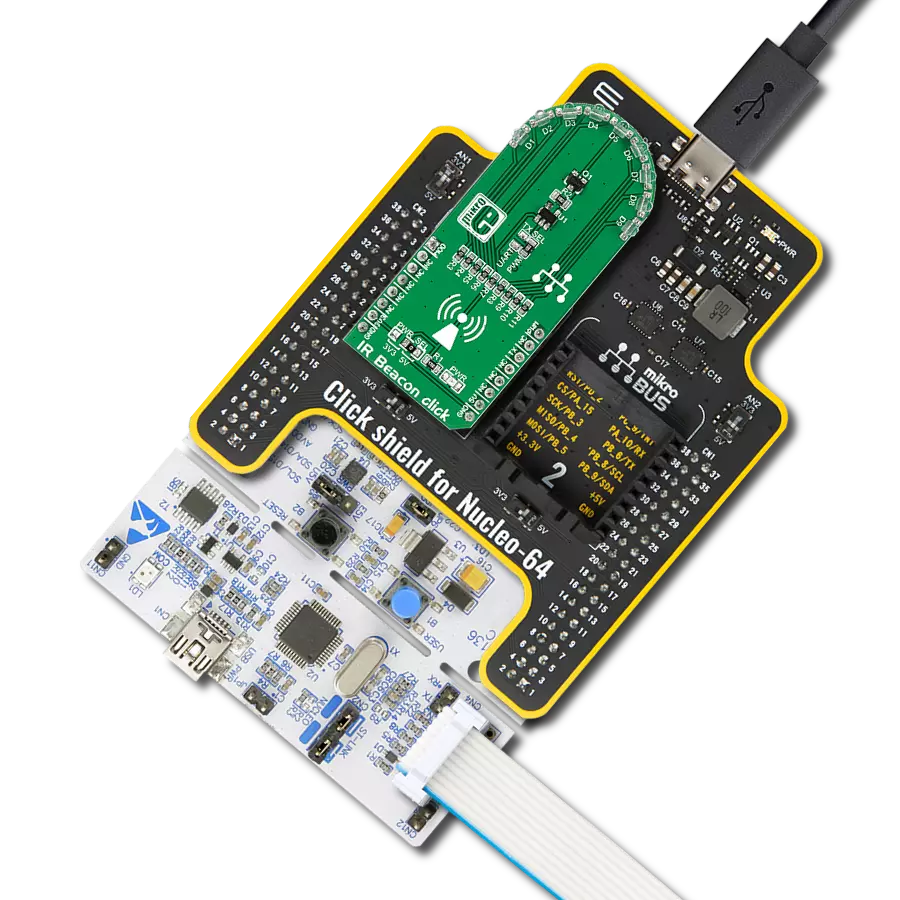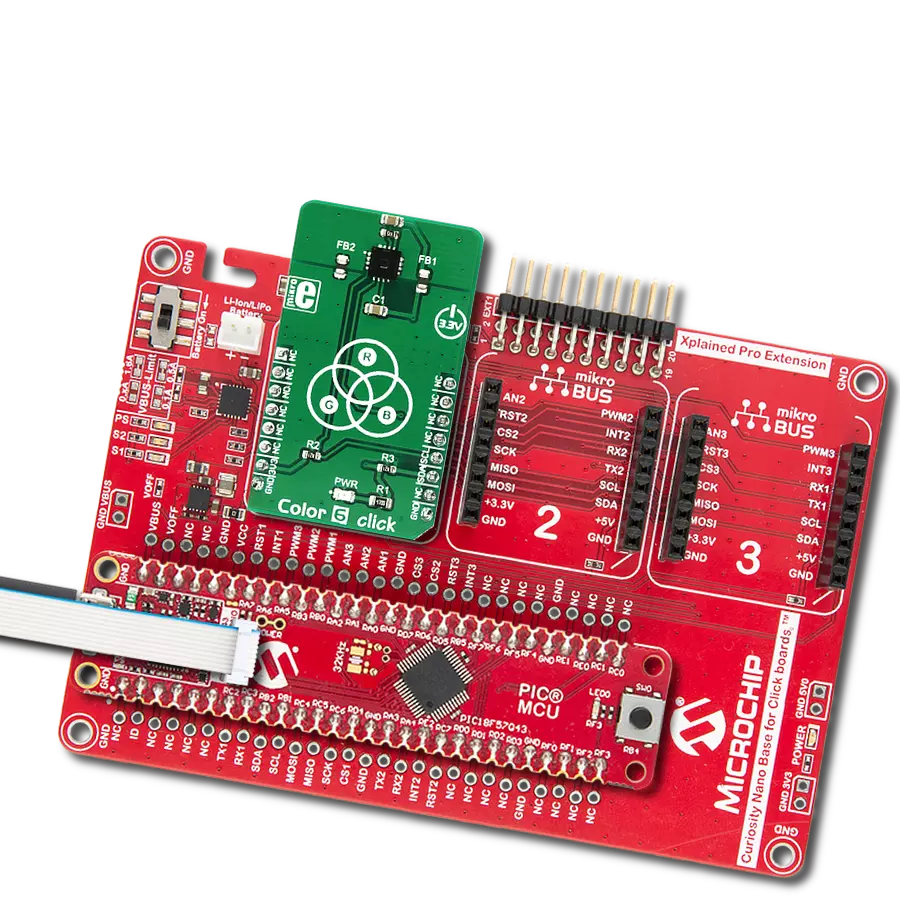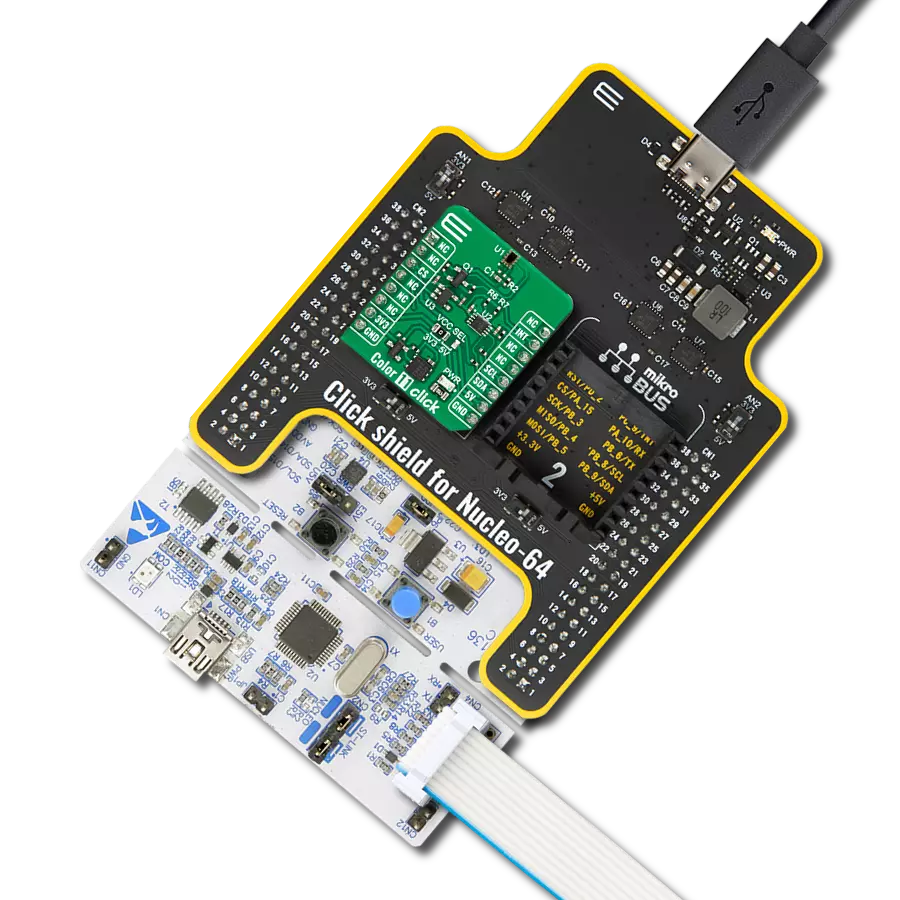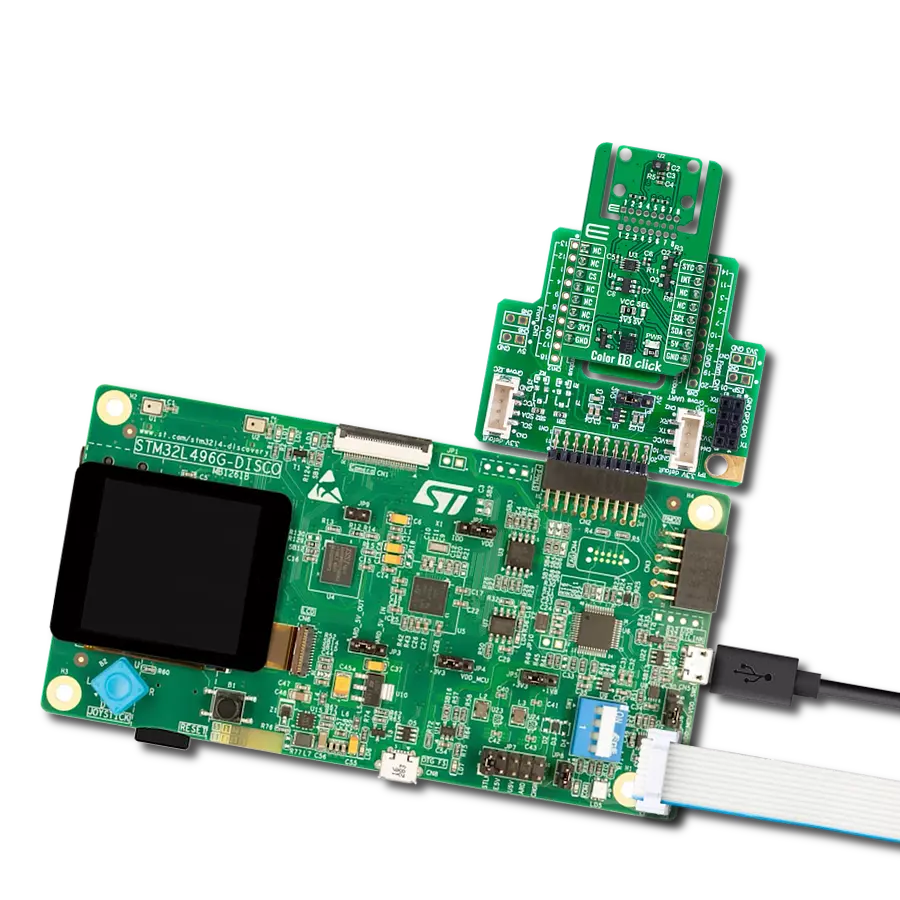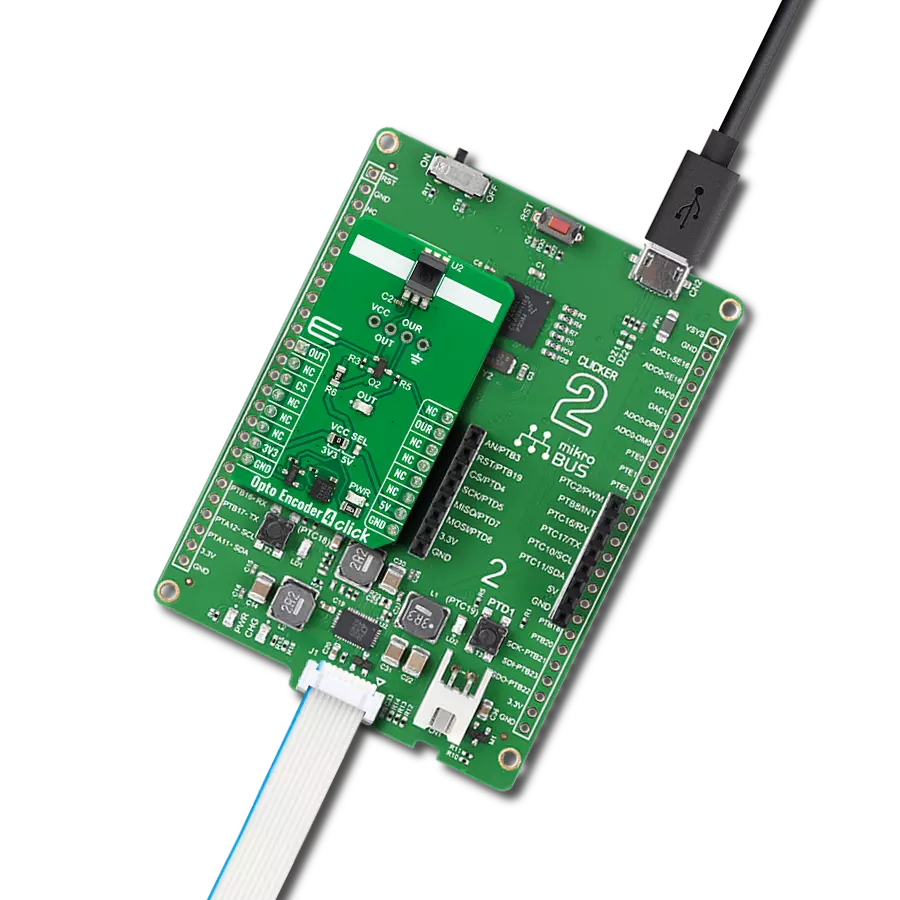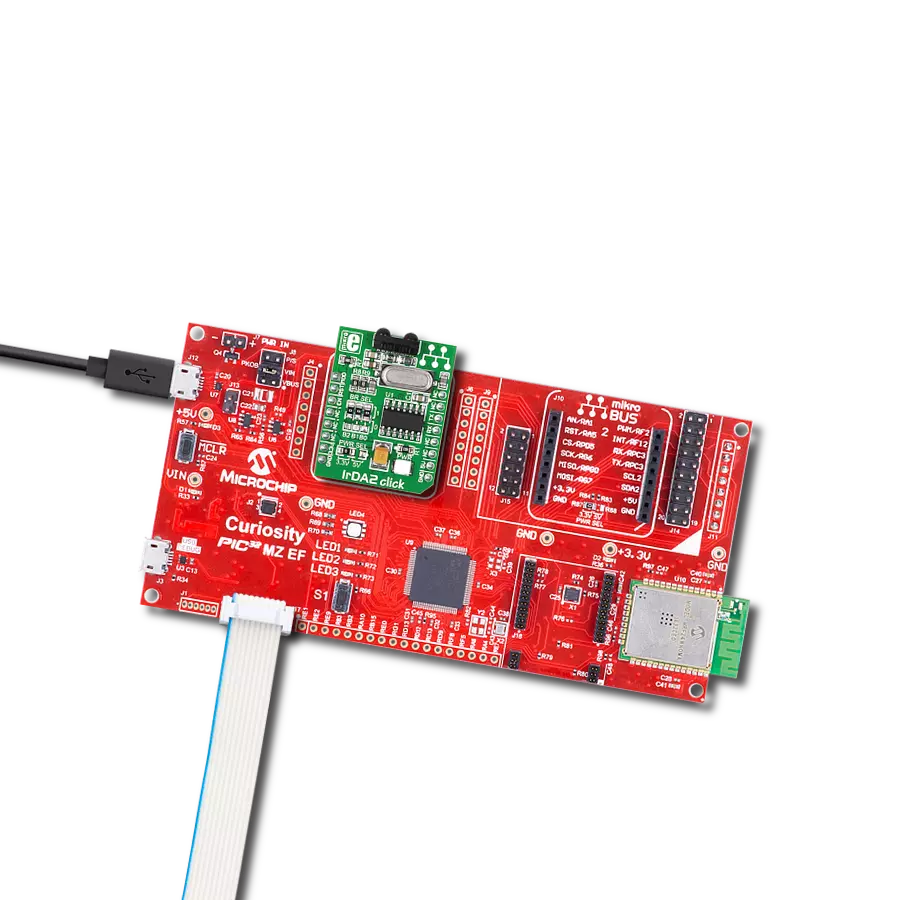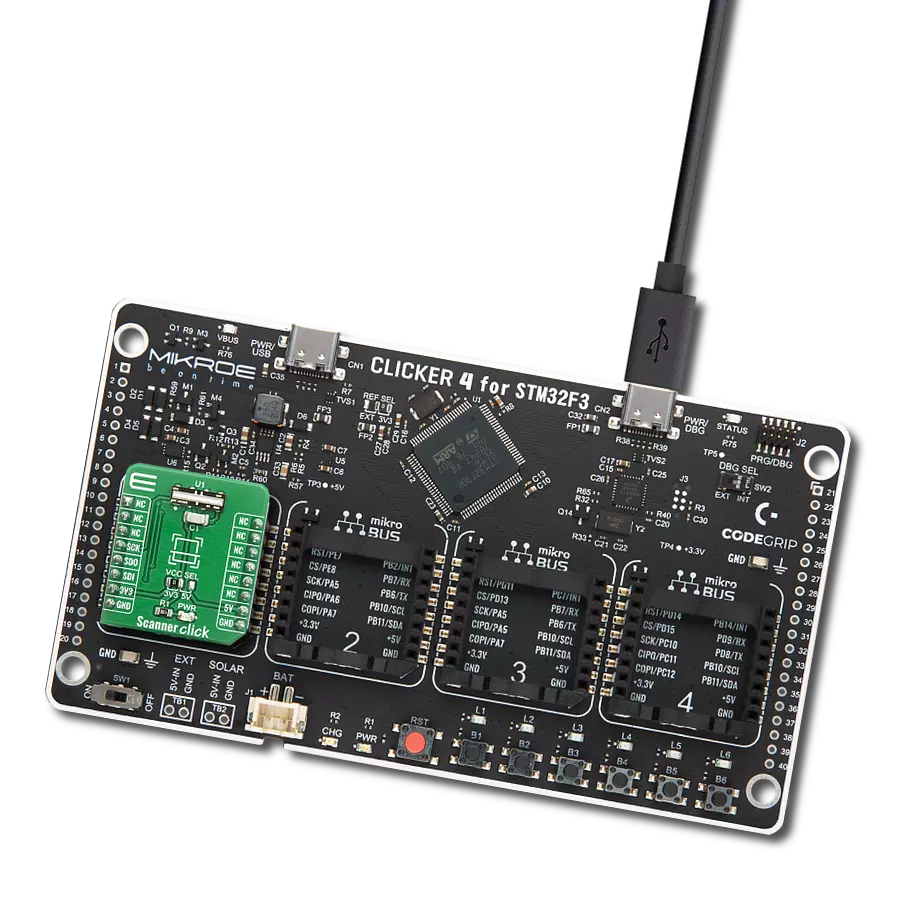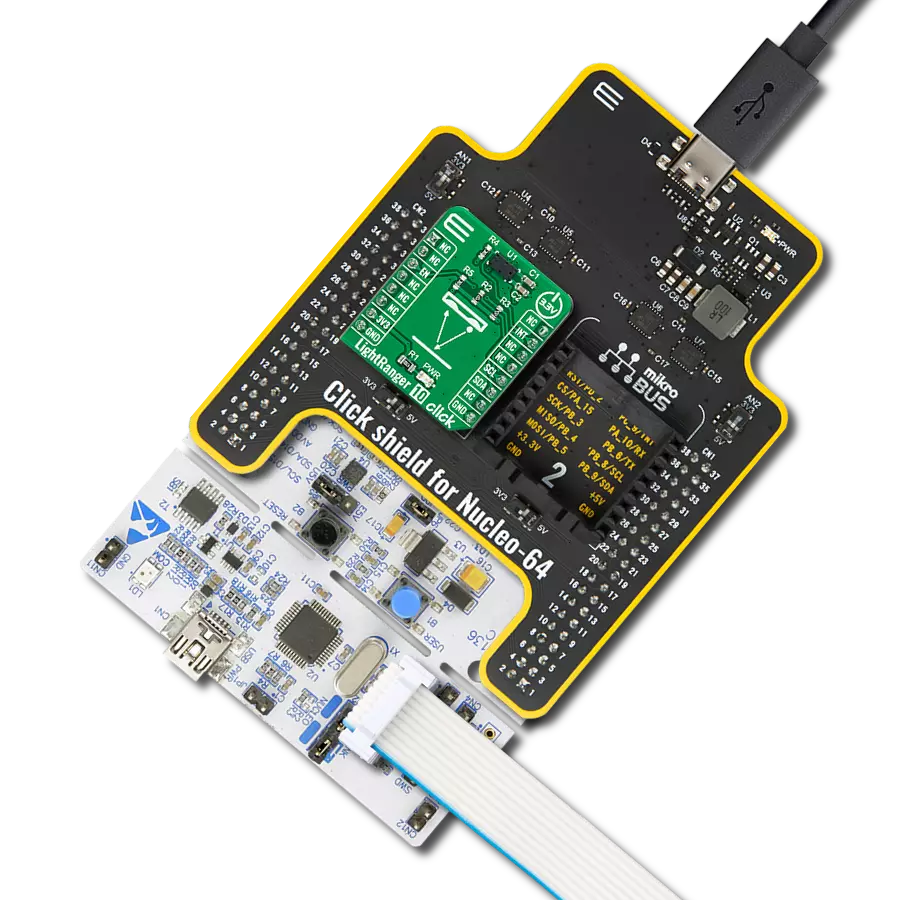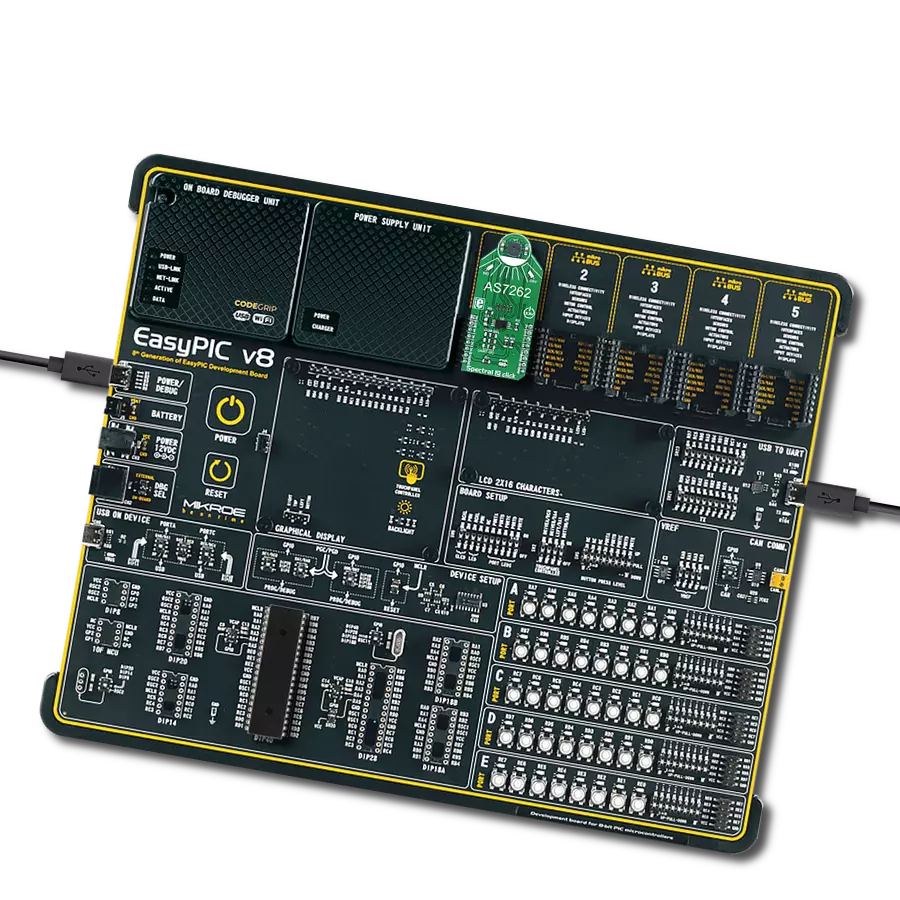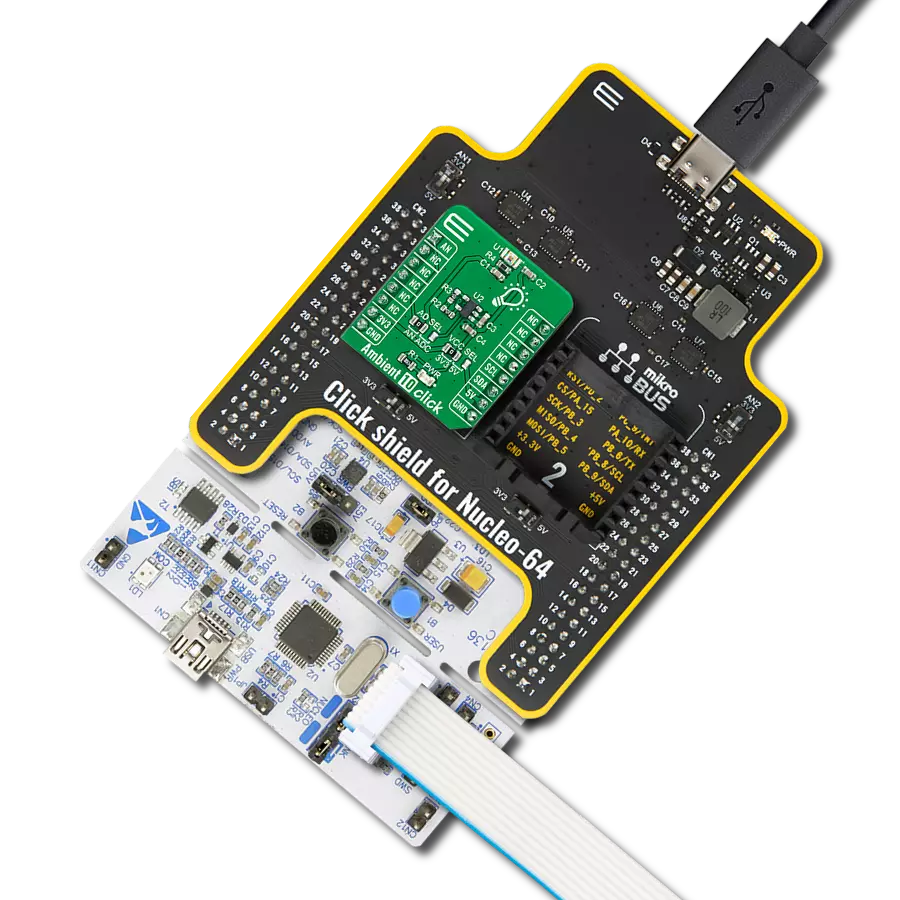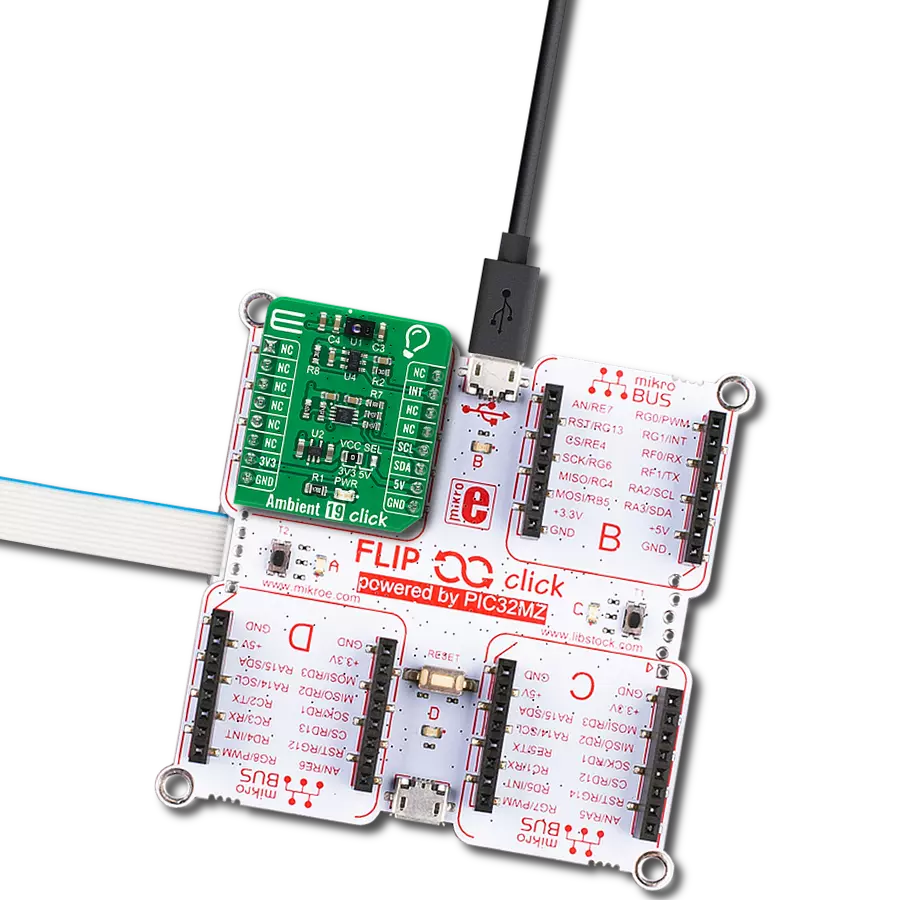An advanced color filtering technology with accurate computation of correlated color temperature and Lux information for your applications
A
A
Hardware Overview
How does it work?
Spectrometer 2 Click is based on the VD6283TX, a color sensor with advanced light flicker extraction from STMicroelectronics. It performs fast and accurate light measurements thanks to an individual ADC with a resolution of 24 bits (16 + 8 bits for high accuracy under low light) and a readout for six color channels: red, green, blue, IR, clear, and visible. Through a serial interface, the color channels can be individually enabled to optimize power consumption alongside 15 programmable gains for a high-dynamic range. Six channels can operate with independent, parallel reading for ALS or flicker operations, one represents a dedicated fast channel for light flicker measurement, and one stands for an internal dark channel. The VD6283TX uses hybrid color filters with precise responses allowing accurate computation of the
correlated color temperature (CCT) and Lux information. Its patented architecture and a high-performance photodiode design can also extract light-flickering frequencies from a minimum of 100Hz and a maximum frequency of 2kHz, including LED square signals, to avoid “banding effects” or check that they are safe for the human eye. Spectrometer 2 Click communicates with MCU using the standard I2C 2-Wire interface with a maximum clock frequency of 1MHz, fully adjustable through software registers. The VD6283TX does not require a specific Power-Up sequence but requires a voltage of 1.8V for its interface and logic part to work correctly. Therefore, a small regulating LDO, the ADP151, provides a 1.8V out of 3.3V mikroBUS™ power rail. Since the sensor for operation requires a power supplyof 1.8V, this Click board™ also
features the PCA9306 voltage-level translator allowing the VD6283TX to work with 3.3V MCU properly. The VD6283TX can stream the following data continuously: ALS color data over the I2C interface and raw flicker data over the AN pin of the mikroBUS™ socket. It also possesses an additional interrupt signal, routed on the INT pin of the mikroBUS™ socket labeled as INT, indicating when a specific interrupt event occurs. This Click board™ can only be operated with a 3.3V logic voltage level. The board must perform appropriate logic voltage level conversion before using MCUs with different logic levels. However, the Click board™ comes equipped with a library containing functions and an example code that can be used as a reference for further development.
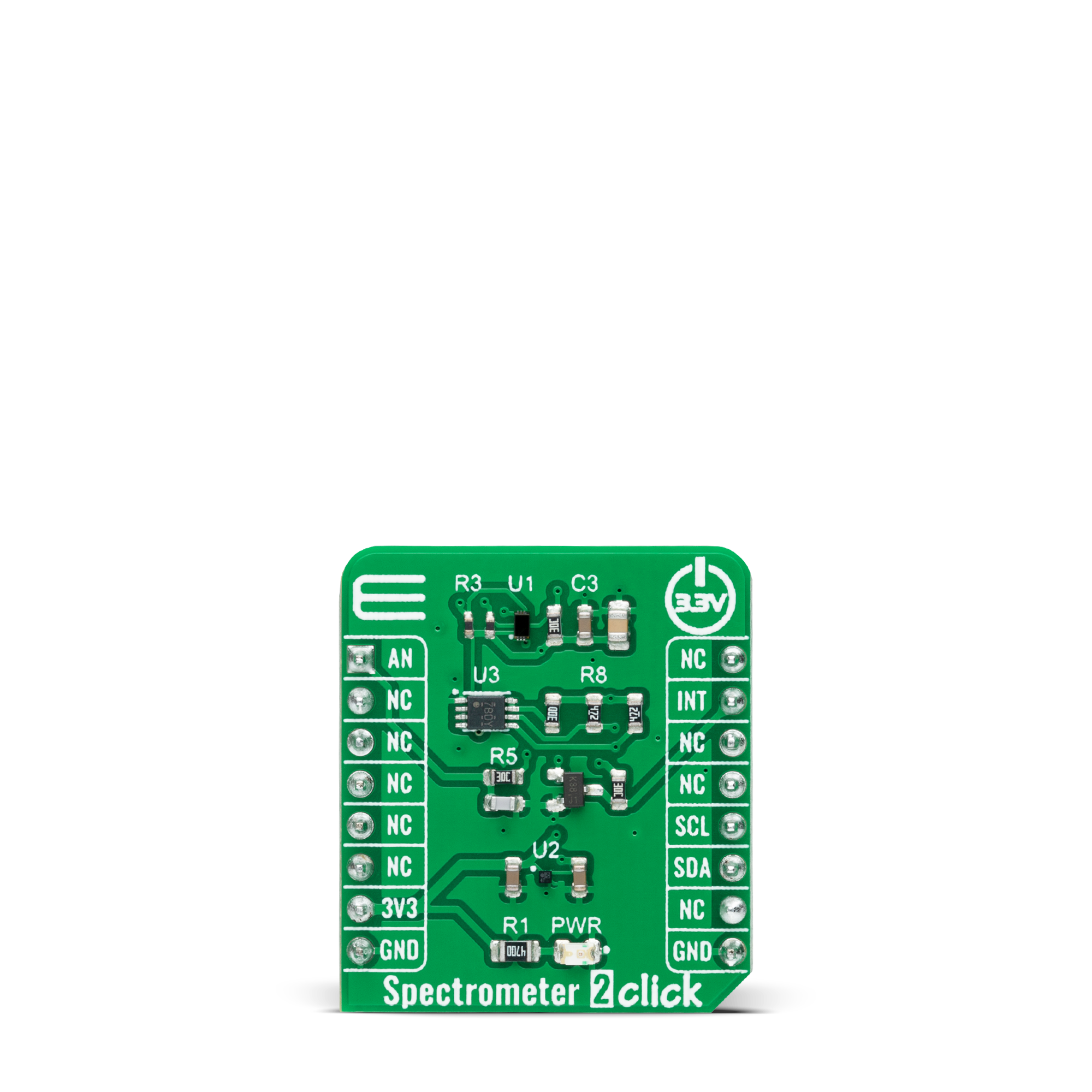
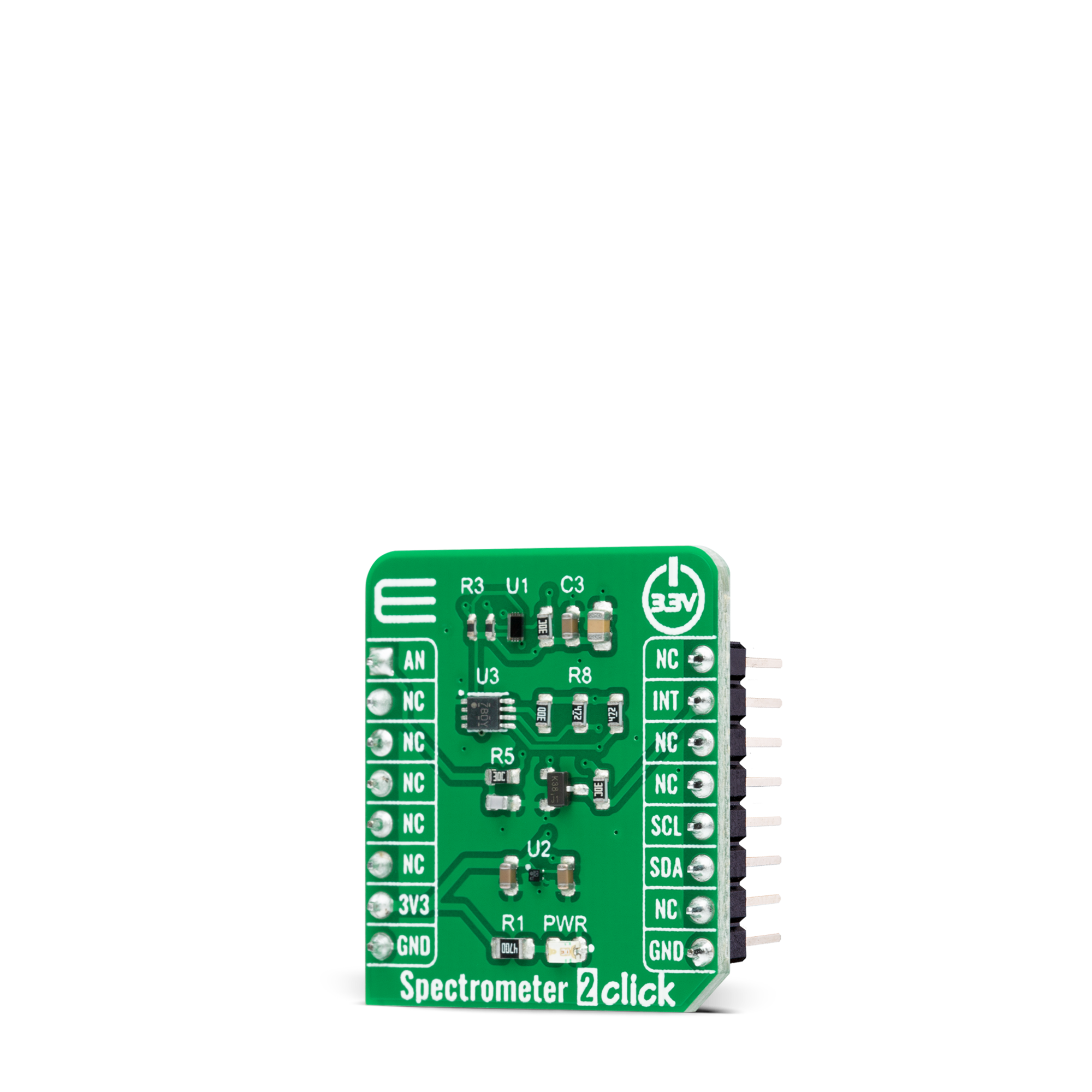
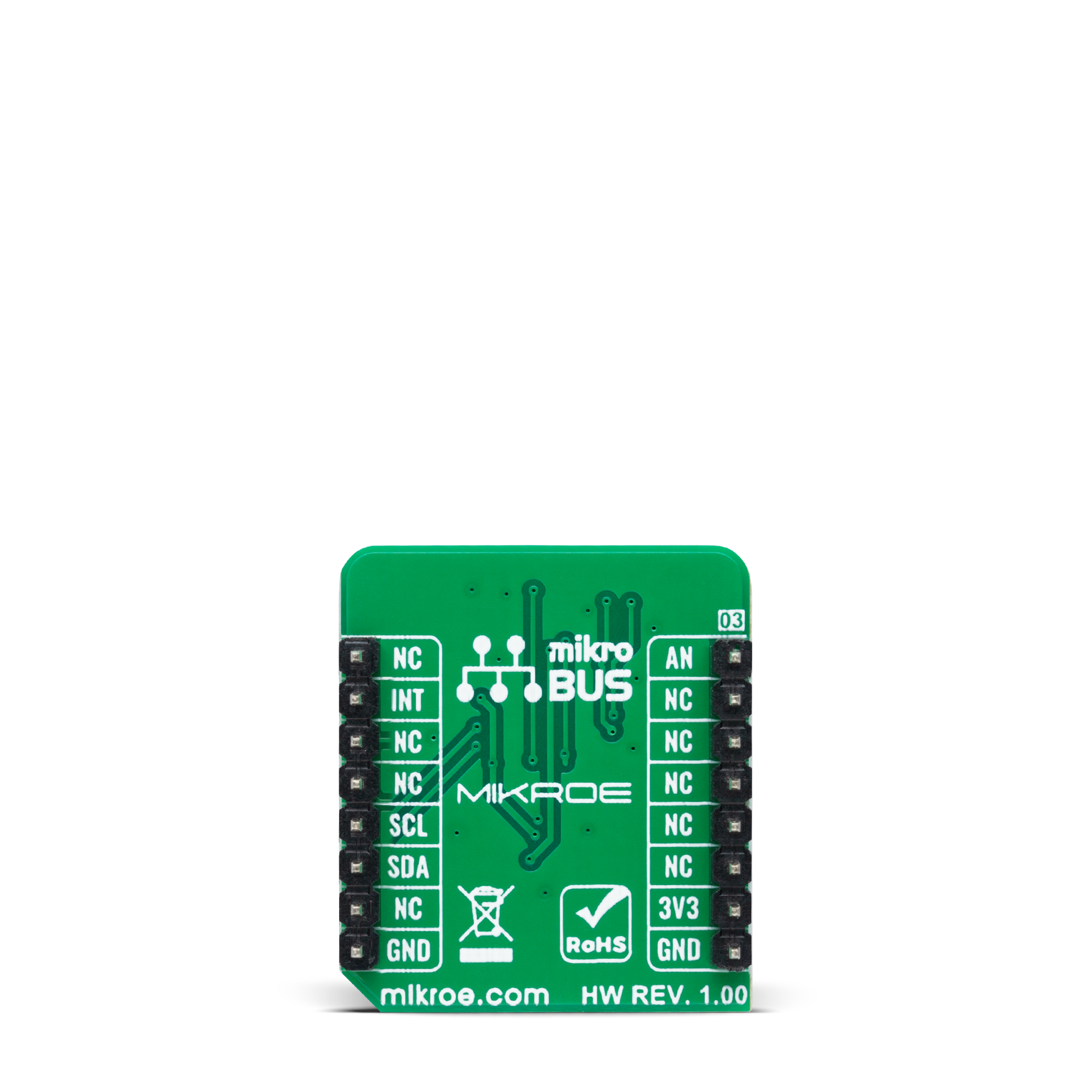
Features overview
Development board
EasyMx PRO v7 for STM32 is the seventh generation of ARM development boards specially designed for the needs of rapid development of embedded applications. It supports a wide range of 32-bit ARM microcontrollers from STMicroelectronics and a broad set of unique functions, such as a powerful onboard mikroProg programmer and In-Circuit debugger over USB-B. The development board is well organized and designed so that the end-user has all the necessary elements, such as switches, buttons, indicators, connectors, and others, in one place. With two different connectors for each port, EasyMx PRO v7 for STM32 allows you to connect accessory boards, sensors, and custom electronics
more efficiently than ever. Each part of the EasyMx PRO v7 for STM32 development board contains the components necessary for the most efficient operation of the same board. An integrated mikroProg, a fast USB 2.0 programmer with mikroICD hardware In-Circuit Debugger, offers many valuable programming/debugging options and seamless integration with the Mikroe software environment. Besides it also includes a clean and regulated power supply block for the development board. It can use a wide range of external power sources, including an external 12V power supply, 7-23V AC or 9-32V DC via DC connector/screw terminals, and a power source via the USB Type-B (USB-B) connector. Communication options such
as USB-UART, USB-HOST/DEVICE, CAN, and Ethernet are also included, including the well-established mikroBUS™ standard, one display option for the TFT board line of products, and a standard TQFP socket for the seventh-generation MCU cards. This socket covers a wide range of 32-bit ARM MCUs, like STM32 Cortex-M3 and -M4 MCUs. EasyMx PRO v7 for STM32 is an integral part of the Mikroe ecosystem for rapid development. Natively supported by Mikroe software tools, it covers many aspects of prototyping and development thanks to a considerable number of different Click boards™ (over a thousand boards), the number of which is growing every day.
Microcontroller Overview
MCU Card / MCU
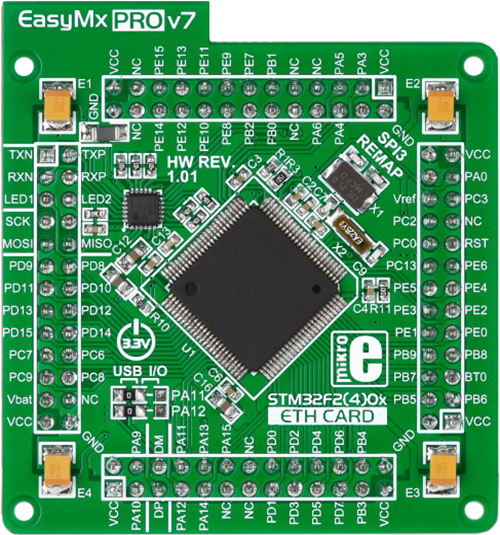
Type
7th Generation
Architecture
ARM Cortex-M3
MCU Memory (KB)
10
Silicon Vendor
STMicroelectronics
Pin count
100
RAM (Bytes)
100
Used MCU Pins
mikroBUS™ mapper
Take a closer look
Click board™ Schematic

Step by step
Project assembly
Software Support
Library Description
This library contains API for Spectrometer 2 Click driver.
Key functions:
spectrometer2_get_dataThis function reads data from 6 ALS channels (Red, Visible, Blue, Green, IR, and Clear).spectrometer2_rgbc_to_hslThis function converts RGBC (red, green, blue, clear) to HSL (hue, saturation, lightness) color value.spectrometer2_get_colorThis function returns the color name flag from the input HSL color.
Open Source
Code example
The complete application code and a ready-to-use project are available through the NECTO Studio Package Manager for direct installation in the NECTO Studio. The application code can also be found on the MIKROE GitHub account.
/*!
* @file main.c
* @brief Spectrometer2 Click example
*
* # Description
* This example demonstrates the use of Spectrometer 2 Click board by reading data
* from 6 ALS channels and converting them to HSL color and displaying those data as
* well as the detected color name on the USB UART.
*
* The demo application is composed of two sections :
*
* ## Application Init
* Initializes the driver and performs the Click default configuration.
*
* ## Application Task
* Waits for the data ready interrupt, then reads the values of all ALS channels and converts
* them to HSL color and displays those data as well as the detected color name on the USB UART
* every 200ms approximately.
*
* @author Stefan Filipovic
*
*/
#include "board.h"
#include "log.h"
#include "spectrometer2.h"
static spectrometer2_t spectrometer2;
static log_t logger;
void application_init ( void )
{
log_cfg_t log_cfg; /**< Logger config object. */
spectrometer2_cfg_t spectrometer2_cfg; /**< Click config object. */
/**
* Logger initialization.
* Default baud rate: 115200
* Default log level: LOG_LEVEL_DEBUG
* @note If USB_UART_RX and USB_UART_TX
* are defined as HAL_PIN_NC, you will
* need to define them manually for log to work.
* See @b LOG_MAP_USB_UART macro definition for detailed explanation.
*/
LOG_MAP_USB_UART( log_cfg );
log_init( &logger, &log_cfg );
log_info( &logger, " Application Init " );
// Click initialization.
spectrometer2_cfg_setup( &spectrometer2_cfg );
SPECTROMETER2_MAP_MIKROBUS( spectrometer2_cfg, MIKROBUS_1 );
if ( I2C_MASTER_ERROR == spectrometer2_init( &spectrometer2, &spectrometer2_cfg ) )
{
log_error( &logger, " Communication init." );
for ( ; ; );
}
if ( SPECTROMETER2_ERROR == spectrometer2_default_cfg ( &spectrometer2 ) )
{
log_error( &logger, " Default configuration." );
for ( ; ; );
}
log_info( &logger, " Application Task " );
}
void application_task ( void )
{
// Wait for the data ready interrupt indication
while ( !spectrometer2_get_int_pin ( &spectrometer2 ) );
spectrometer2_als_channels_t als_channels;
if ( ( SPECTROMETER2_OK == spectrometer2_clear_interrupt ( &spectrometer2 ) ) &&
( SPECTROMETER2_OK == spectrometer2_get_data ( &spectrometer2, &als_channels ) ) )
{
spectrometer2_hsl_t hsl;
spectrometer2_rgbc_to_hsl( &als_channels, &hsl );
log_printf ( &logger, "\r\n Hue: %.1f deg\r\n", hsl.hue );
log_printf ( &logger, " Saturation: %.1f %%\r\n", hsl.saturation );
log_printf ( &logger, " Lightness: %.1f %%\r\n", hsl.lightness );
switch ( spectrometer2_get_color ( &hsl ) )
{
case SPECTROMETER2_RED_COLOR:
{
log_printf( &logger, " Color: RED\r\n" );
break;
}
case SPECTROMETER2_YELLOW_COLOR:
{
log_printf( &logger, " Color: YELLOW\r\n" );
break;
}
case SPECTROMETER2_GREEN_COLOR:
{
log_printf( &logger, " Color: GREEN\r\n" );
break;
}
case SPECTROMETER2_CYAN_COLOR:
{
log_printf( &logger, " Color: CYAN\r\n" );
break;
}
case SPECTROMETER2_BLUE_COLOR:
{
log_printf( &logger, " Color: BLUE\r\n" );
break;
}
case SPECTROMETER2_MAGENTA_COLOR:
{
log_printf( &logger, " Color: MAGENTA\r\n" );
break;
}
case SPECTROMETER2_WHITE_COLOR:
{
log_printf( &logger, " Color: WHITE\r\n" );
break;
}
case SPECTROMETER2_BLACK_COLOR:
{
log_printf( &logger, " Color: BLACK\r\n" );
break;
}
default:
{
log_printf( &logger, " Color: UNKNOWN\r\n" );
break;
}
}
}
}
int main ( void )
{
/* Do not remove this line or clock might not be set correctly. */
#ifdef PREINIT_SUPPORTED
preinit();
#endif
application_init( );
for ( ; ; )
{
application_task( );
}
return 0;
}
// ------------------------------------------------------------------------ END
Additional Support
Resources
Category:Optical





